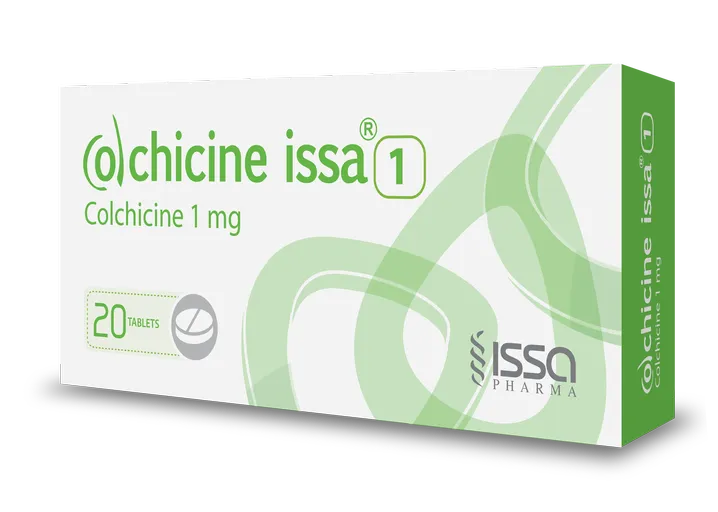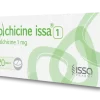COMPOSITION AND EXCEPIENTS
Each tablet of Colchicine issa 0.5 contains 0.5 mg of active substance Colchicine.
The other ingredients are Corn starch, Lactose Monohydrate, Magnesium Stearate, Povidone.
Each tablet of Colchicine issa 1 contains 1 mg of active substance Colchicine.
The other ingredients are Sucrose, Lactose Monohydrate, Magnesium Stearate, Polyvidone, Erythrosine E127 (Lake Red Colorant).
PROPERTIES
The exact mechanism of action of Colchicine in gout is not known. Colchicine apparently exerts its effect by reducing the inflammatory response to the deposited crystals and also by diminishing phagocytosis.
Colchicine diminishes lactic acid production by leukocytes directly and by diminishing phagocytosis and thereby interrupts the cycle of urate crystal deposition and inflammatory response that sustains the acute attack.
Colchicine is not an analgesic, although it relieves pain in acute attacks. It is not a uricosuric agent and will not prevent the progression of gout to chronic gouty arthritis.
PHARMACOKINETIC PROPERTIES
Absorption: Readily absorbed after oral administration, peak concentrations in plasma occur after 2 hours.
Plasma half-life about 1 hour, but 60 hours in leucocytes, which is increased in renal function impairment and decreased in hepatic function impairment.
Excretion: Colchicine is mainly excreted in the faeces, with 10-20% in the urine. The percentage excreted in the urine rises in patients with hepatic disease
INDICATIONS
Adults:
- Colchicine is used for the treatment of acute gout. It is also used for theprophylaxis of recurrent gout and to prevent acute attacks during the initial treatment with allopurinol or uricosuric drugs.
- Prevention and treatment of FMF (familial Mediterranean fever).
Pediatric patients:
Colchicine is indicated in Familial Mediterranean Fever for prophylaxis of attacks and prevention of amyloidosis.
POSOLOGY AND METHOD OF ADMINISTRATION
Tablet should be swallowed with a glass of water.
Adults:
Treatment for acute gout: 1 mg initially, followed by 500 mcg every 4 hours until relief of pain isobtained or vomiting or diarrhoea occurs, or until a total dose of 6 mg has been reached. The course should not be repeated within 3 days.
Prophylaxis:
500 mcg weekly or up to 2-3 times daily.
Prophylaxis of recurrent gout and prevention of acute attacks during initial treatment with allopurinol or uricosuric drugs: 500 mcg 2-3 times daily.
Familial Mediterranean fever(FMM):
The recommended dosage is 1 mg to 2 mg daily. It should be increased as needed to control disease and as tolerated in increments of 0.25 mg/day to maximum recommended daily dose.
If intolerable side effects develop, the dose should be decreased in quantity of 0.25 mg/day. The total daily dose may be administered in one to two divided doses.
Administration in Elderly:
The adult dose should apply with caution in patients with renal impairment, where the dosage should be reduced by up to 50%.
Pediatric patients:
Colchicine should only be prescribed under the supervision of a medical specialist with the necessary knowledge and experience.
A starting dose should be administered orally based on age:
- 0.5mg/day in children less than 5 years of age.
- 1mg/day in children from 5 to 10 years of age.
- 1.5mg/ day in children over 10 years.
The dose could be given as a single dose or doses higher than 1mg/day couldbe divided and given twice daily. Colchicine dosage should be increased in a stepwise fashion (eg, 0.25mg/step) up to a maximum of 2mg/day to control disease in patients who do not clinically respond to the standard dosage. Any increase of the daily dose should be monitored closely for adverse effects.
In children with amyloid nephropathy, higher daily doses up to 2mg/day might be needed.
Careful monitoring is needed in the presence of impaired renal or liver function. For these patients, the starting dose should be reduced by 50% (e.g. ≤1mg/day).
CONTRAINDICATIONS
Hypersensitivity to Colchicine, serious gastro-intestinal, renal, hepatic, cardiac disorders, and blood dyscrasias.
Colchicine should not be used in patients undergoing haemodialysis since it cannot be removed by dialysis or exchange transfusion.
Colchicine should not be used in patients with severe renal impairment (creatinine clearance less than 10ml/minute).
Colchicine is contraindicated in patients with renal or hepatic impairment who are taking a Pglycoprotein
or a strong CYP3A4 inhibitor.
WARNINGS AND PRECAUTIONS
- Colchicine is potentially toxic so it is important not to exceed the doseprescribed by a medical specialist.
- Colchicine should be given with great care to elderly or debilitated patientsand those with cardiac, hepatic, renal or gastro-intestinal disease.
- Colchicine has adversely affected spermatogenesis in humans under certain conditions of therapy.
- Periodic blood counts should be done in patients receiving long termtherapy. The physician should be notified if skin rash, sore throat, fever, unusual bleeding,bruising, tiredness or weakness, numbness or tingling occurs.
- The medication should be discontinued as soon as gout pain is relieved or at the first sign of nausea,vomiting, stomach pain, or diarrhoea. If symptoms persist, The physician should be notified.
DRUG INTERACTION
- Colchicine has been shown to induce reversible malabsorption of vitamin B12,apparently by altering the function of ileal mucosa.
- Colchicine may impair the absorption of fat, sodium, potassium, nitrogen, and other activelytransported sugars. This may lead to decreased serum cholesterol and caroteneconcentrations.
- Colchicine is inhibited by acidifying agents but is potentiated by alkalinizing agents.
- Colchicine may increase sensitivity to CNS depressants and enhance theresponse to sympathomimetic agents.
- Colchicine may cause false-positive results when testing urine for RBC or haemoglobin.
- Colchicine may react with cyclosporin leading to an increased risk of nephrotoxicity and increased plasma-cyclosporin concentration.
- Colchicine has been reported to interfere with urinary determinations of 17-hydroxycorticoids using the Reddy, Jenkins and Thorn procedure.
- Concomitant use with clarithromycin may lead to colchicine toxicity.Colchicine is a substrate for both CYP3A and the efflux transporter, Pglycoprotein(Pgp). Clarithromycin and other macrolides are known to inhibitCYP3A and Pgp. When clarithromycin and colchicine are administered together, inhibition of Pgp and/or CYP3A by clarithromycin may lead toincreased exposure to colchicine. Patients should be monitored for clinicalsymptoms of colchicine toxicity.Concomitant use with erythromycin may also lead to colchicine toxicity.
Pregnancy and lactation:
Colchicine has been shown to be teratogenic in animals and there is a risk of teratogenicity or of fetal chromosomal damage in humans. Colchicine should not be used during the first trimester of pregnancy and only used in late stages of pregnancy where the risk/benefit ratio has been considered.
As Colchicine may be excreted in breast milk. It should not be given to lactating mother because of the risk of cytotoxic effects.
UNDESIRABLE EFFECTS
- Colchicine therapy may cause elevated alkaline phosphatase and SGOT values.
- Decreased thrombocyte values may be obtained during therapy.
- Bone marrow depression with aplastic anaemic, agranulocytosis, leukopenia or thrombocytopenia may occur in patients receiving long term therapy.
- Loss of hair, rashes, vesicular dermatitis, peripheral neuritis or neuropathy, myopathy, anuria, renal damage, haematuria and purpura has been reported with prolonged administration of colchicine.
- Vomiting, diarrhoea, abdominal pain and nausea may occur, especially when maximum doses are necessary for a therapeutic effect. These may be particularly troublesome in the presence of peptic ulcer or spastic colon.
- At toxic doses colchicine may cause severe diarrhea, generalized vascular damage and renal damage with haematuria and oliguria. To avoid more serious toxicity, the use should bediscontinued when these symptoms appear, regardless of whether joint pain has been relieved.
- Dermatoses have been reported; hypersensitivity reactions may occur infrequently.
OVERDOSE
Colchicine has a narrow therapeutic window and is extremely toxic in overdose. Patients at particular risk of toxicity are those with renal or hepatic impairment, gastrointestinal or cardiac disease, and patients at extremes of age.
Colchicine overdose is complex and specialist advice should be promptly obtained. There is often a delay of up to 6 hours before toxicity is apparent, and some features of toxicity may be delayed by 1 week or longer.
Following colchicine overdose, all patients, even in the absence of early symptoms, should be referred for immediate medical assessment. Symptoms of acute overdosage may be delayed (3 hours on average): nausea, vomiting, abdominal pain, hemorrhagic gastroenteritis, volume depletion, electrolyte abnormalities, leukocytosis, and hypotension in severe cases.
Treatment: No antidote is available, Elimination of toxins by gastric lavage within one hour of acute poisoning, Close clinical and biological monitoring in hospital and Symptomatic and supportive treatment should be done.
STORAGE CONDITIONS
Store at room temperature, below 25° C , protected from light, in the outer carton.
PACKAGING
Colchicine issa (0.5 – 1) mg is supplied as blister strips (Aluminum – White P.V.D.C), each strip contains 10 tablets, and each box contains 2 strips with enclosed leaflet (20 Tablets per box).



